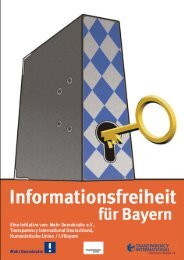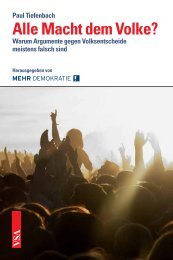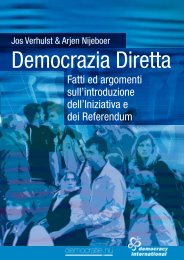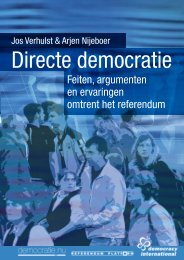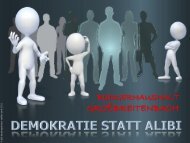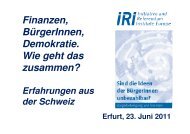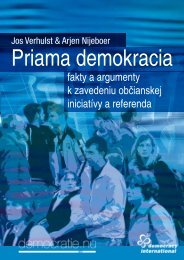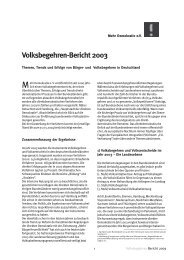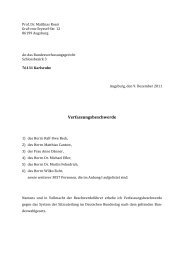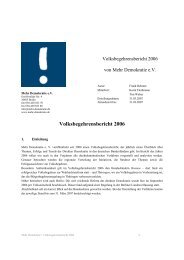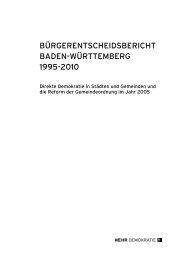Facts and Arguments about the Introduction of Initiative and ...
Facts and Arguments about the Introduction of Initiative and ...
Facts and Arguments about the Introduction of Initiative and ...
Create successful ePaper yourself
Turn your PDF publications into a flip-book with our unique Google optimized e-Paper software.
a municipality close to Reutlingen, <strong>the</strong>re was also a citizens’<br />
initiative against a similar bunker. The local CDU did not<br />
call a boycott <strong>the</strong>re. The result was that 57% <strong>of</strong> <strong>the</strong> electorate<br />
took part in <strong>the</strong> referendum <strong>and</strong> 90% <strong>of</strong> <strong>the</strong> voters<br />
rejected <strong>the</strong> building <strong>of</strong> <strong>the</strong> bunker. The citizens’ initiative<br />
was <strong>the</strong>refore successful in this instance. In ano<strong>the</strong>r municipality,<br />
Schramberg, <strong>the</strong> citizens’ initiative against <strong>the</strong> local<br />
bunker plans was also successful, despite a call from <strong>the</strong><br />
CDU to boycott it. On this occasion, <strong>the</strong> text <strong>of</strong> <strong>the</strong> CDU’s<br />
call for a boycott was prematurely leaked, so that <strong>the</strong> bunker’s<br />
opponents still had time to respond <strong>and</strong> counter <strong>the</strong><br />
manoeuvre. The local newspapers also published criticisms<br />
<strong>of</strong> <strong>the</strong> CDU’s boycott call. In <strong>the</strong> end, 49.25% <strong>of</strong> <strong>the</strong> electorate<br />
in Schramberg participated in <strong>the</strong> referendum; <strong>the</strong><br />
minimum 30% turnout quorum was achieved <strong>and</strong> 88.5%<br />
<strong>of</strong> <strong>the</strong> voters were against <strong>the</strong> bunker.<br />
A boycott can also be conducted along organisational lines. A<br />
well-known example comes from <strong>the</strong> town <strong>of</strong> Neuss, where<br />
<strong>the</strong> first municipal referendum in Nordrhein-Westfalen was<br />
held on 3 September 1995. The subject was <strong>the</strong> building,<br />
close to <strong>the</strong> town hall, <strong>of</strong> a hotel which would destroy some<br />
<strong>of</strong> <strong>the</strong> town centre’s green belt. The CDU majority succeeded<br />
in getting <strong>the</strong> public vote to fail because <strong>of</strong> <strong>the</strong> participation<br />
quorum <strong>of</strong> 25%. It is generally known that when referendums<br />
in large towns concern building plans in a single specific<br />
district, relatively few people will vote, because <strong>the</strong>y do<br />
not feel personally affected by <strong>the</strong> issue or have <strong>the</strong> impression<br />
that a lack <strong>of</strong> knowledge <strong>of</strong> <strong>the</strong> local situation means<br />
<strong>the</strong>y cannot judge properly (a referendum in Antwerp on<br />
<strong>the</strong> design <strong>of</strong> <strong>the</strong> municipal square in Ekeren, for instance,<br />
will attract very few voters from o<strong>the</strong>r districts such as <strong>the</strong><br />
South or Hoboken, <strong>the</strong> majority <strong>of</strong> residents <strong>of</strong> which will<br />
have never even been to Ekeren in person). The municipal<br />
council <strong>of</strong> Neuss used a series <strong>of</strong> measures to discourage<br />
<strong>the</strong> voters. Postal voting was not allowed (although for <strong>the</strong><br />
council elections 15% <strong>of</strong> <strong>the</strong> votes were submitted by post).<br />
Instead <strong>of</strong> <strong>the</strong> 100 polling stations that were provided for<br />
<strong>the</strong> council elections, only 30 locations were opened for this<br />
vote. Result: only 18.5% <strong>of</strong> <strong>the</strong> electorate took part in <strong>the</strong> referendum.<br />
Of <strong>the</strong>se, it is true that almost 80% were against<br />
<strong>the</strong> municipal council’s hotel plan, but because <strong>the</strong> quorum<br />
was not achieved, <strong>the</strong> citizens’ initiative was declared void.<br />
In Belgium, on 10 April 1995, a law was implemented that<br />
provided for non-binding <strong>and</strong> non-compulsory referendums<br />
at municipal level. A participation quorum was set at<br />
40% <strong>of</strong> <strong>the</strong> electorate. If less than 40% <strong>of</strong> <strong>the</strong> electorate participate<br />
in <strong>the</strong> referendum, <strong>the</strong> ballots must be destroyed<br />
uncounted.<br />
Although <strong>the</strong> referendums were non-compulsory <strong>and</strong> nonbinding<br />
<strong>and</strong>, moreover, a very high signature threshold <strong>of</strong><br />
10% was imposed, this led to initiatives in a number <strong>of</strong><br />
towns. In 1996, in <strong>the</strong> municipalities Genk <strong>and</strong> As in Limburg,<br />
<strong>the</strong> citizens requested a referendum on <strong>the</strong> construction<br />
<strong>of</strong> a commercial complex on <strong>the</strong> site <strong>of</strong> an ab<strong>and</strong>oned<br />
mine. In <strong>the</strong> As municipality, <strong>the</strong> municipal council decided<br />
to decline <strong>the</strong> referendum, but a vote was held in Genk on 13<br />
October 1996. Only 37.47% <strong>of</strong> <strong>the</strong> electorate turned out for<br />
<strong>the</strong> vote <strong>and</strong>, in <strong>the</strong> name <strong>of</strong> Belgian democracy, <strong>the</strong> ballots<br />
were not counted but were destroyed. Middle-class organisations<br />
<strong>and</strong> an extreme left-wing party had called on people<br />
not to vote. The first referendum held under <strong>the</strong> new law<br />
was immediately a victim <strong>of</strong> a successful call for a boycott.<br />
20<br />
In Gent, on 14 December 1997, a citizens’ initiative referendum<br />
was held on <strong>the</strong> city council’s planned construction<br />
<strong>of</strong> <strong>the</strong> so-called Belfort car-parking garage in <strong>the</strong> city centre.<br />
The city council had decided in advance that it would consider<br />
<strong>the</strong> result as binding, but <strong>the</strong> SP <strong>and</strong> <strong>the</strong> VLD, which<br />
formed <strong>the</strong> majority coalition in Gent, called on <strong>the</strong> voters<br />
to boycott <strong>the</strong> ballot. On this occasion <strong>the</strong> boycott failed by<br />
a small margin, because 41.12% <strong>of</strong> <strong>the</strong> electorate turned out<br />
<strong>and</strong> <strong>of</strong> <strong>the</strong>se 95% voted against <strong>the</strong> car park.<br />
In Sint-Niklaas, on 28 June 1998, a referendum was held<br />
on <strong>the</strong> construction <strong>of</strong> an underground car park. As in<br />
Gent, <strong>the</strong> quorum was just met: 40.28% <strong>of</strong> <strong>the</strong> electorate<br />
turned out. Of <strong>the</strong>se 92% voted against <strong>the</strong> car park. The<br />
vote was a touch-<strong>and</strong>-go affair because <strong>the</strong> largest party in<br />
Sint-Niklaas, <strong>the</strong> Christian Democratic CVP <strong>and</strong> <strong>the</strong> local<br />
NCMV (traders’ organisation), had called on people not to<br />
vote. “The referendum is a bad formula. Whoever votes ‘yes’<br />
only ensures that those who vote ‘no’ achieve <strong>the</strong> required<br />
40%. The ‘yes’ voter would do better to stay at home”, according<br />
to local CVP chairman Julien Vergeylen (Gazet van<br />
Antwerpen newspaper, 17 June 1998). The socialist leader,<br />
Freddy Willockx, said: “The problem is that because <strong>of</strong> <strong>the</strong><br />
CVP’s call for a boycott we do not have an objective picture<br />
<strong>of</strong> what <strong>the</strong> people really want. There were probably some<br />
70% to 80% <strong>of</strong> <strong>the</strong> Sint-Niklaas voters effectively against<br />
<strong>the</strong> car park, but we will never know that with certainty”<br />
(Gazet van Antwerpen, 29 June 1998).<br />
Although <strong>the</strong> participation quorum was subsequently lowered<br />
(<strong>and</strong> <strong>the</strong> signature threshold raised), after <strong>the</strong>se <strong>and</strong><br />
o<strong>the</strong>r dubious experiences <strong>the</strong>re have since been very few<br />
initiatives.<br />
Italy has provided <strong>the</strong> most recent perverse examples. On<br />
18 April 1999, a referendum was held <strong>the</strong>re on reforming<br />
<strong>the</strong> electoral system. The reforms were supported by most<br />
<strong>of</strong> <strong>the</strong> political parties; 49.6% <strong>of</strong> <strong>the</strong> electorate turned out<br />
<strong>and</strong> <strong>of</strong> <strong>the</strong>se 91% voted for <strong>the</strong> reforms. But <strong>the</strong> voters had<br />
taken all <strong>the</strong>ir trouble for nothing: because <strong>the</strong> participation<br />
quorum <strong>of</strong> 50% was not quite reached, <strong>the</strong> reforms did<br />
not go ahead. An interesting fact: in <strong>the</strong> south <strong>of</strong> Italy, <strong>the</strong><br />
mafia had actively called for a boycott <strong>and</strong> <strong>the</strong> 40% turnout<br />
to <strong>the</strong> south <strong>of</strong> Naples was far below <strong>the</strong> national average.<br />
The mafia decided that <strong>the</strong>ir c<strong>and</strong>idates were more easily<br />
elected using <strong>the</strong> existing electoral system, <strong>and</strong> manipulated<br />
<strong>the</strong> participation quorum so that <strong>the</strong> mafia won against<br />
a public majority <strong>of</strong> more than 90%.<br />
Unhappily, such boycott campaigns occur regularly in Italy.<br />
The latest example is <strong>the</strong> referendum <strong>of</strong> 12 <strong>and</strong> 13 June<br />
2005, in which four proposals for <strong>the</strong> liberalisation <strong>of</strong> <strong>the</strong><br />
highly restrictive law on assisted fertility for women were<br />
voted on. With <strong>the</strong> support <strong>of</strong> Pope Benedict XVI, <strong>the</strong> president<br />
<strong>of</strong> <strong>the</strong> Italian bishops, Cardinal Ruini, aptly named in<br />
this case, actively called for a boycott. “Cardinal Ruini finds<br />
not voting <strong>the</strong> best way to reject <strong>the</strong> proposals. After all,<br />
a referendum is only valid when at least half <strong>of</strong> <strong>the</strong> electorate<br />
votes. Given <strong>the</strong> fact that it was already established<br />
that those who would vote ‘yes’ would clearly be in <strong>the</strong> majority,<br />
by voting ‘no’ Catholics would only help to achieve<br />
<strong>the</strong> quorum <strong>and</strong> thus unwillingly reinforce <strong>the</strong> ‘yes’ camp;<br />
this was <strong>the</strong> reasoning”, as reported by <strong>the</strong> news website<br />
KatholiekNederl<strong>and</strong>.nl (www.katholieknederl<strong>and</strong>.nl/actualiteit/2005/5/nieuws_568842.html).<br />
And Ruini’s strategy



